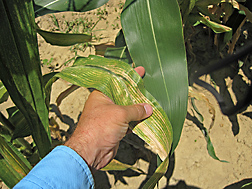This page has been archived and is being provided for reference purposes only. The page is no longer being updated, and therefore, links on the page may be invalid.
| Read the magazine story to find out more. |
|
|
|
|
Scientists Test Corn Genes with MAGIC
By Stephanie Yao
September 13, 2010
A new method for testing gene function in maize plants has been created by U.S. Department of Agriculture (USDA) scientists and university cooperators.
Peter Balint-Kurti, a geneticist with the USDA's Agricultural Research Service (ARS) at the agency's Plant Science Research Unit in Raleigh, N.C., teamed up with colleagues Guri Johal and Cliff Weil at Purdue University to create MAGIC, an acronym that stands for "mutant-assisted gene identification and characterization." ARS is the USDA's principal intramural scientific research agency.
MAGIC is a gene-centered approach that uses mutant genes or other genetic variants controlling a trait of interest as "reporters" to identify novel genes and variants for that trait. This method offers researchers a new way of sifting through the large amount of natural genetic variation to identify and map versions of genes important for the control of specific, agriculturally useful traits.
Balint-Kurti and colleagues recently demonstrated MAGIC's usefulness when examining hypersensitive response in maize. Hypersensitive response is a defense mechanism used by all plants in which one or a few cells surrounding the site of a pathogen attack kill themselves to prevent further spread of the pathogen.
The research team experimented with mutant gene Rp1-D21, which causes hypersensitive-response lesions to form spontaneously all over a plant regardless of whether a pathogen is present. The researchers crossed a plant containing Rp1-D21 with two popular maize inbred lines, one of which partially suppresses hypersensitive response and the other which partially enhances it, to identify a genomic location involved in the pathway controlling the start or local spread of hypersensitive response.
The scientists are currently conducting more hypersensitive response studies. Funded by the National Science Foundation, the scientists are now using MAGIC to identify other genomic regions responsible for hypersensitive response.
This research supports the USDA priority of promoting international food security.
Details about MAGIC were recently published in the scientific journals Crop Science and Genetics.
Read more about this and other research to improve corn in the September 2010 issue of Agricultural Research magazine.

